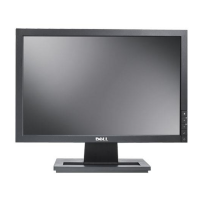
Do you have a question about the Dell E1709W and is the answer not in the manual?
General safety guidelines and warnings for monitor operation and handling.
Information regarding the use of certified replacement parts to maintain safety standards.
Guidelines for servicing, including soldering and wire management practices.
Overview of the monitor's system architecture and component interactions.
Detailed explanation of the inverter's Pulse Width Modulation control circuit.
Description of the inverter's output stage and over-voltage/current protection.
Explanation of the Pulse Width Modulation circuit for power supply.
Details on the AC input stage and Electromagnetic Interference filtering.
Circuitry for controlling high voltage to low voltage conversion in the power supply.
Circuitry for DC 12V and 5V outputs and their feedback mechanisms.
Description of the Interface board circuitry, including RGB and DDC signals.
Details on input signals for RGB capture and ESD protection.
Functionality of front panel buttons and their connection to the main IC.
Pin assignments and functions for the TSUM1PER-LF-2 chip.
Explanation of voltage regulator circuits providing power to various components.
Pinout details for the D-SUB video connector.
Pinout details for the AC power input connector.
Pinout details for internal connectors, including panel and keypad.
Pin assignments for backlight connectors.
Pin assignments for keypad and compatible connectors.
Pin details for the TSUM1PER-LF-2 chip's analog interface.
Pin details for the TSUM1PER-LF-2 chip's serial flash interface.
Pin details for the TSUM1PER-LF-2 chip's LVDS interface.
Pin details for the TSUM1PER-LF-2 chip's General Purpose Input/Output interface.
Pin details for various miscellaneous interface connections.
Pin assignments for power supply connections.
Pin assignments for the U108 serial flash memory.
Pin details for the LD7575 PWM power controller.
Pin details for the INL837 CCFL inverter controller IC.
Visual representation of monitor components for disassembly and assembly.
Flowchart illustrating the disassembly sequence of the E1709W monitor.
Flowchart illustrating the assembly sequence of the E1709W monitor.
Description of front panel button functions and hot key operations.
Details on On-Screen Display menus, settings, and options.
Procedure to enter the monitor's factory mode for advanced settings.
Information on the automatic burn-in pattern generation and exit methods.
Procedure for automatically calibrating monitor color parameters.
Instructions for upgrading monitor firmware via serial flash.
Testing OSD functions, individual and compound keys, and contrast.
Procedures for testing color temperature, modes, and VGA detector functionality.
Testing for panel flicker, brightness, contrast, and power consumption modes.
General troubleshooting advice, EDID/firmware considerations, and pattern checks.
Troubleshooting steps for power supply issues resulting in no display or LED off.
Troubleshooting steps for power issues causing the LED to be amber.
Troubleshooting steps when the backlight fails to activate.
Troubleshooting steps when the picture is missing despite backlight and functions being OK.
List of components and part numbers for the interface board.
Schematic diagram for the monitor's interface board.
Detailed schematic sections related to the TSUM1PER-LF-2 integrated circuit.
Schematic for the power board's DC to AC conversion stage.
Schematic for the inverter control board and its connections.
Detailed schematic of the inverter control IC and associated components.
Schematic for the power control board using the LD7575 IC.
Schematic showing power supply components like fuse, transformer, and regulators.
Schematic of the 12V rectifier board and its components.
Top layer PCB layout for the power and inverter board.
Bottom layer PCB layout for the power and inverter board.
Top layer PCB layout for the Interface board.
Bottom layer PCB layout for the Interface board.
PCB layout for the keypad module, showing top and bottom layers.